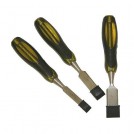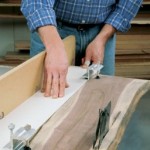 If you want to increase your income and love wood work, then you could think about starting a home based business. A person who has good woodworking skills can easily start his or her business from home, start small and build a portfolio of your best work.
If you want to increase your income and love wood work, then you could think about starting a home based business. A person who has good woodworking skills can easily start his or her business from home, start small and build a portfolio of your best work.
If you want to make a career in woodworking then it is indeed an excellent idea. There are many examples of people who have become rich starting a woodworking business. If you are really serious then it is just a matter of time to become successful in this business. Woodworking business can be regarded as a good source of income.
Many have doubled their income by doing woodworking part time. Handcrafted wood is in great demand. If the handcrafted wood has a beautiful design and is of good quality then you can simply ask the price you want from the customer. If you are good at wooden toys then it is indeed a golden opportunity to start a woodworking business at home. Children simply love to play with wooden toys. Most wooden products are marketable today.
If you are a skilled worker in making furniture such as cabinets, chairs then you should not think twice to start a woodworking business. Cabinets and chairs are used every day and also in great demand. Hence there is no way that you will remain idle if you start a woodworking business. In fact the orders of making cabinets and furniture will be so much that you will have to hire skilled workers
If you want to start a woodworking business then you should know the requirements for opening this business. More importantly you should be clear about the type of wooden products that are going produce. From the type of wooden products you will definitive idea about the tools and supplies that you will need to start the business.
You can also advertise your business through newspapers or internet to attract potential customers. You can also create your own website where the clients can directly get a glimpse of your products. A website is indeed a nice way to showcase all your wooden products.You should also know the name of suppliers in your city that can provide various woods as well as wood handling tools.
At any cost sub standard material should not be used in making wooden products. Quality is important especially in wooden products that would be used daily. A substandard product will definitely spoil your reputation which will have an adverse effect on your woodworking business.
Click here for a complete guide on how to start and operate a successful woodworking business.
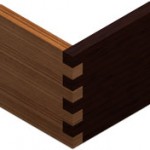 How many wood joints types do you know?
How many wood joints types do you know?
There are several wood joints types and in this article we want to review some of them.
Square-ended butt joints
It is possible to make flat frames and simple box structures utilizing square-cut corner joints. Use sawn wood for rough carpentry, but plane the wood square beforehand for good-quality cabinet work. Since glue alone is rarely adequate to make a sturdy butt join, hold the parts together with fine nails or glued blocks of wood.
Mitered butt joint
When reviewing the main wood joints types we cannot forget the mitered butt joints. The classic joint for picture frames, the mitered butt joint makes a neat right-angle corner without visible end grain. Cutting wood at 45 degrees produces a relatively large surface area of weight frames, just add glue and set the join in a miter clamp for a while.
Edge-to-edge butt joint
Lumber selection is an important as good edge-to-edge joints when making wide panel from solid wood. To make sure the panel will remain flat; try to use quarter-sawn wood – that is, with the end-grain growth rings running perpendicular to the face side of each board. If that is not possible, arrange them so the direction of ring growth alternates from one board to the next. Also try to make sure the surface grain on the boards runs in the same direction, to facilitate the final cleaning up of the panel with a plane. Before you get to work, number each board and mark the face sides.
More wood joints types
Tongue-and groove joint
Use a combination plane to cut a tongue-and-groove joint by hand. This kind of plane is similar to a standard plow plane, but comes with a wider range of cutters, including one designed to shape a tongue on the edge of a workpiece. Cut the tongue first, then change the cutter and plane a matching groove.
Doweled frame joints
Frames made with doweled butt joints are surprisingly strong. Nowadays, most factory-made furniture incorporates dowel joints even for chair rails, which must be capable of resisting prolonged and considerable strain. In most cases, two dowels per joint are sufficient. Place them a minimum of ¼ inch from both edges of the rail.
Edge-to-edge dowel joint
Among the other wood joints types we have the edge-to-edge dowel joint. In particular, when constructing a wide solid-wood panel, you can make a particularly strong join between boards by inserting a dowel every 9 to 12 inches.
Carcass butt joints
When constructing a carcass with butt joints that are reinforced with multiple dowels, it pays to buy extra-long slide rods and additional drill bit guides for the doweling jig. A doweling jig is required for many of the doweled joints. This can be an expensive piece of machinery and if you are not going to use it very often, it might be worth looking into renting one or borrowing one from someone.
Corner bridle joint
Among the many wood joints types, a corner bridle joint is adequate for relatively lightweight frames, provided they are not subjected to sideways pressure, which tends to force bridle joints out of square. The strength of the bridle is improved considerably if you insert two dowels through the side of the joint after the glue has set.
Other wood joints types
Mitered bridle joint
The mitered bridle is cut in a similar fashion as the conventional corner joint, but is a more attractive alternative for framing, because end grain appears on one edge only.
T-bridle joint
The T-bridle joint serves as an intermediate support for a frame and with modifications, is sometimes used to join a table leg to the underframe when a long rail requires support. Unlike the corner bridle, which is relatively weak under sideways pressure, the t-bridle is similar in strength to the mortise-and-tenon joint.
Lap joint
In this review of wood joints types we have also to consider the lap joint. A basic lap joint is only marginally stronger than a straightforward butt joint, but it is an improvement in appearance since most of the end grain is concealed. As a result, it is sometimes used as a relatively simple way of connecting a drawer front to drawer sides.
Through mortise and tenon joint
The through joint, where the tenon passes right thought the leg, is used a great deal for construction frames of all kinds. Maybe it is one of the most used wood joint types. With the end grain showing, possibly with wooden wedges used to spread the tenon, it is an attractive businesslike joint. Always cut the mortise first, since it is easier to make the tenon fit exactly than the other way around.
We hope that this short review of wood joints types has been useful. If you want to learn more about wood joint types and other woodworking techniques, simply subscribe to our FREE newsletter.
keywords: wood joints types, types of wood joints
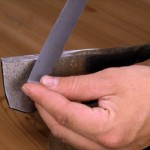 There are several ways to keep your woodworking tools sharp. Most are kept sharp by using an abrasive whetstone to wear the metal to a narrow cutting edge. The better-quality natural stones are more expensive, but you can get satisfactory results from cheaper, synthetic stones. As part of the sharpening, whetstones are lubricated with water or oils to make sure the steel does not overheat and to prevent fine particles of metal and stone from clogging the abrasive surface.
There are several ways to keep your woodworking tools sharp. Most are kept sharp by using an abrasive whetstone to wear the metal to a narrow cutting edge. The better-quality natural stones are more expensive, but you can get satisfactory results from cheaper, synthetic stones. As part of the sharpening, whetstones are lubricated with water or oils to make sure the steel does not overheat and to prevent fine particles of metal and stone from clogging the abrasive surface.
Generally, whetstones are sold as rectangular blocks – known as bench stones – for sharpening everyday tools or as small knife edges or teardrop section stones for honing gouges and carving chisels. Blades can also be sharpened on a perfectly flat metal plat that has been dusted with abrasive powder.
Oilstones
The majority of man-made and natural sharpening stones are lubricated with light oil. Novaculite generally considered to be the finest oilstones available are only found in Arkansas. This compact silica crystal occurs naturally in various grades. The course, mottled-gray Soft Arkansas stone removes metal quickly and is used for the preliminary shaping of edged tools. The white Hard Arkansas stone puts the honing angle on the cutting edge, which is then refined and polished with the Black Arkansas stone. Even finer is the rare translucent variety. Synthetic oilstones are made from sintered aluminum oxide or silicon carbide. Categorized as coarse, medium and find, man-made sharpening stones are far cheaper than their natural equivalents.
Waterstones
Because it is relatively soft and friable, a sharpening stone that is lubricated with water cuts faster than an equivalent oilstone; fresh abrasive particles are exposed and released constantly as a meta blade is rubbed across the surface of the waterstone. However, this soft bond also makes a waterstone vulnerable to accidental damage, especially when honing narrow chisels that could score the surface. Naturally occurring waterstones are so costly that most tool suppliers offer only the synthetic varieties which are almost as efficient.
Diamond stones
Extremely durable coarse – and fine-grade sharpening ‘stones’ comprise a nickel plated steel plate that is embedded with monocrystalline diamond particles and bonded to a rigid polycarbonate base. These fast-cutting sharpening tools, available as bench stones and narrow files, can be used dry or lubricated with water. Diamond stones will sharpen steel and carbide tools.
Metal lapping plates
Available as alternatives to conventional sharpening stones, oiled steel or cast-iron plates sprinkled with successively finer particles of silicon carbide produce an absolutely flat polished back to a plane or chisel blade and razor-sharp cutting edges. For the ultimate cutting edge on steel tools, finish with diamond-grit compound spread on a flat steel plate. Diamond abrasives are also used to hone carbide-tipped tools.
Exclusive $20 Discount on 16,000 woodworking plans and projects. Activate your discount now: TedsWoodworkingDiscount
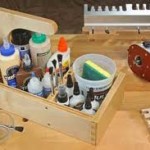 Although there are approximately 1,500 adhesive products manufactured in the United States, less than a dozen are suitable for woodworking. Before getting into the individual types of adhesives, it might be helpful to know how glue bonds wooden parts together. It is helpful to understand a little about the chemical makeup of wood and how an adhesive interacts with these components during the bonding process. Wood is a complex mixture of organic chemicals and water.
Although there are approximately 1,500 adhesive products manufactured in the United States, less than a dozen are suitable for woodworking. Before getting into the individual types of adhesives, it might be helpful to know how glue bonds wooden parts together. It is helpful to understand a little about the chemical makeup of wood and how an adhesive interacts with these components during the bonding process. Wood is a complex mixture of organic chemicals and water.
About 95 percent of a board consists of cellulose, hemicelluloses and lignin, which form the structural matrix of wood and give it its rigidity, strength and elasticity. The remaining five percent contained in dry wood is composed of tannins, essential oils, resins, gums, coloring agents and sugars. This chemical mixture of extractives is responsible for wood’s smell, color and decay resistance. Unfortunately, extractive in some resinous woods, such as teak and rosewood can interfere with the gluing process.
Once an adhesive is applied to adjacent wood surfaces and the pieces are clamped up, the structural elements of the wood of wood are linked together by the bonding process. First, the liquid adhesive is absorbed into the wood and its polymer molecules intermingle with the structural fibers of wood. Then, the adhesive’s polymer molecules coalesce or come together, surround the structural fibers and harden, mechanically interlocking the fibers.
Thermosetting glues such as epoxy, urea formaldehyde and resorcinol cure by a chemical reaction, usually after two components have been mixed, while thermoplastic adhesives, such as yellow and white glues cure by evaporations. Once either type of glue is dry, the think layer of cured adhesive between the two wood surfaces acts like a bridge holding the boards together.
Exclusive $20 Discount on 16,000 woodworking plans and projects. Activate your discount now: TedsWoodworkingDiscount
There are many woodworkers who believe that using hand tools and only hand tools is the way to make anything. From furniture to birdhouses, only Hand Tools will do for them. Others will use a combination of Hand Tools and portable power tools and perhaps sedentary equipment like a table saw or other large machinery which helps move the process along faster.
Hand tools are quiet and help you connect with the wood on a different level than using machines to rip or cut the wood. Here is a list of several hand tools you should have in case you find yourself wanting to become one with the wood.
Chisels – always purchase a good set of wooden-handled bench chisels (¼ in, ¾ in, 1in) and a ¼ in mortise chisel. Wooden handles are more comfortable and more visually appealing than plastic and if they ever split or get chipped you can replace them with little effort. Western chisels are preferred to the Japanese chisels, which some say requires too much work, especially if you’re just getting started in woodworking. If you can afford it, buy a 2in wide bench chisel in addition to the four smaller ones. Its extra-wide blade is ideal for paring tenons.
Sharpening stones – waterstones are cleaner than oilstones. They come in a variety of grits, 800-, 1,200-, 4,000- and 6,000- grit stones.
Combination square – usually comes in 12 in. this tool will mark out stock at 90 and 45 degrees and can double as a ruler and a marking gauge. Buy the best you can afford because you will be using it the most.
Hammer – a good 13-oz, claw hammer is ideal for general cabinet work and is useful for installation work as well. They are inexpensive yet get the job done right the first time.
Caver’s mallet – this is useful for driving joints home and for chopping out mortises. A medium-sixed turned lignum vitae mallet is approximately $20-25.
Dovetail and tenon saws – used for cutting small pieces, an 8in dovetail saw with a turned handle and 18 teeth per inch. A 10in brass-backed dovetail saw with 14 teeth per inch for cutting dovetails and tenons. Japanese saws will also do a great job; however, they can require delicate handling and replacement blades are often expensive.
Block plane – block plane can either be a low-angle or the regular angle. They are solid, compact and well made. A block plane is useful for planning small parts, flushing surfaces and planning end grain.
Smoothing plane #3 – a smoothing plane is used for final planning of surfaces as well as for shooting edges on short pieces and for faring joints. Expect to pay upwards of $100 for a good smoothing plane #3.
Rabbet plane – there are several planes that fit the bill, this plane is used to trim rabbets, plane into corners and trim joints flush. Some of them have a removable front half to convert it to a chisel plane.
Spokeshaves – this is a type of plane used primarily to round edges, make spindles and fair concave curves. The short sole of a spokeshave is mounted between tow handles. The blade is generally held in place with a cap iron. They can be used with either a pulling or a pushing motion.
Cabinet scraper – they are inexpensive, work well and last for what seems like forever. Scrapers are good for smoothing hardwood and veneered surfaces, either before or in lieu of sanding.
Burnishers – these are smooth rods of hard steel used to put an edge on a scraper. They can be round, oval or triangular in section. A highly polished burnisher creates a smooth edge on the scraper, which in turn leaves the scraped wood smoother. The shank of a Phillips-head screwdriver often works well as a burnisher.
Drill bits – the drill bits found in a woodshop include twist drills, brad-point bits, Forstner bits and spade bits, each has a distinct advantages and limitations.
Clamps – there are a number of clamps used to squeeze pieces of wood together particularly during assembly and gluing. Bar clamps consists of two jaws mounted on a length of steel bar, usually and I-shaped in section. A pipe clamp is similar except that it substitutes a pipe for the I-bar and is less ridged. Bar and pipe clamps are best suited for assembling wide surfaces, such as tabletops and for putting together large carcasses.
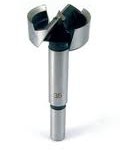
Benjamin Forstner (25 March 1834 – 27 February 1897), was an American gunsmith, inventor and dry goods merchant.
Forstner was born in Beaver County, Pennsylvania. His successful invention of the Forstner bit, patented on September 22, 1874, was to make him a rich man. Without the lead screw (which Forstner called the “gimlet-point”) and cutting lips of more conventional wood boring bits it would prove especially useful to gunsmiths like himself and other high-end woodworkers. The bit was unsurpassed in drilling an exceedingly smooth-sided hole with a flat bottom. It was better than the Russell Jennings twist bits for boring at an angle and not following the grain of the wood. Forstner eventually worked out licensing arrangements for the manufacture and sale of his bit by a number of companies, most notably two Connecticut firms: the Colt Firearms Company of Hartford and the Bridgeport Gun Implement Company, successors (in 1886) to the Union Metallic Cartridge Company. Even today, the Forstner bit continues to be manufactured, although it has changed to a split-ring design.
Forstner also invented an electric motor.
Finally, you have decided to build the deck chair you promised your grandmother for her seventy something birthday. So months before the occasion, you had your workshop ready, your protective gear set in place, your materials were already handpicked but unfortunately you haven’t shopped for the woodwork machineries you will be needing to start your first ever wood project. Now, you realized you definitely have to buy them, but what do you need to buy?
Going to a hardware store with your credit card without knowing what you really need to buy may lead you to a disaster. Although it may seem easy to load and load your cart with power tools, the task of choosing from a variety of woodwork machines available in the market can be intimidating and to some extent may also be disheartening especially for amateurs who just want to pursue a hobby or for those who just want to exercise their knack for carpentry. By looking at the cost, purchasing power tools that may not be suited for first-timers can pierce holes in their wallets and buying something beyond the must haves might end up storing cold rarely used carpentry machineries comfortably in the basement.
So here are some notes about some woodwork machineries that a new woodworker needs to know before purchasing his own set of power tools.
Sanders. There are several types of sanders available out there but it is recommendable to have one that can be effective in polishing large surface areas and another for polishing the hard to reach corners such as a finishing sander.
Finishing sanders come in block sanders and random orbit. Both tools are used as a finishing sander but each excels in different applications. A random orbit sander is better used for polishing large areas efficiently. Meanwhile, a block sander furnishes a better finish while also having the advantage of being able to reach into corners.
One advantage of using a block sander over a random orbit is its compatibility to standard sandpaper since the latter needs specific circular sheets which can make the running cost higher. So if you are on a budget, a block/finishing sander is more practical. Although it may take longer to get a good finish, the end result will be far better.
Saws. Before purchasing a saw, you must consider not only its cost but more importantly its versatility. One that possesses great versatility is the bayonet saw or jigsaw. Owning one is like having a band saw, a scroll saw and, to a limited extent, a circular saw. This power tool really needs to be considered when buying your first ever saw.
To maximize this great tool to your advantage, the bayonet saw can be fixed upside down onto a bench. So instead of usually pushing the saw over the wood, you can push the wood over the bayonet saw just like you would when using a band saw.
The major limitations that this very versatile saw have are its inability to cut in a straight line and to cut anything thicker than about 1 1/2″.
Drills. When buying a drill, it’s a battle between cordless or corded drill. It’s a matter of choosing according to what most woodwork projects you think you probably venture into. While the appealing advantage of a cordless drill is its portability, they are not well suited to masonry work. This cannot be intended for non-wood drilling. This is because a cordless’ drill bit does not revolve as fast and its battery quickly drains if used to drill into brick. But cordless drills are still enough for occasional masonry work.
When you are considering buying a cordless drill think about the longevity of its battery and also how long it takes to recharge it. Check if it has speed control and whether it has reversible functions, allowing you to remove screws as you can fasten them.
Router. There are two distinct types of router. One is the plunge router and the other is fixed also known as the standard router. Both types can provide the equal results, although each type is appropriate for particular jobs. But if you have limited budget for a router, it is recommendable to buy a fixed router. Not only does it provide a more accurate cut for depth, it is especially useful when the routed area begins in the middle of the wood rather than at the edge. You can also attach your fixed router to a router table whereas a plunge router cannot.
These are some of the woodwork machineries that you need to consider when you want to fill your workshop with power tools. Although it’s not expected to have them all at once, at least you are now familiar with what to look for what you really need.
Have you been working as a woodworking craftsman for ages or have you started recently? Whether you’re an experienced craftsman or a total rookie you might want to save some money and you can do it by purchasing used woodworking equipment instead of new tools. It’s possible to save plenty of money but it’s important to choose the right equipment and to buy the things from the right place.
There are only a few truly indispensible hand tools for woodworking today. Near the top of the list would be the basic chisel. This is a tool that does it all, from carefully paring away thin shavings in intricate detailed work to quickly scooping out large chunks of waste wood. You will find chisels in every basic aspect of woodworking from furniture making to trim carpentry to woodcarving.
There are several different types and sizes of chisels one should carry in their woodworking shop and each is designed for a specific job. You could consider purchasing a 4 piece set which includes ¼-, ½-, ¾- and a 1 inch beveled bench chisel with blade lengths from 4 to 6 inches. Plastic handles are best because they can stand up to being hit by a mallet and are comfortable to hold for long periods of time. If you only have the budget for one, purchase a ¾ inch chisel and be sure to purchase a reputable brand because quality counts, it will hold up to repeated sharpening longer.
Using your chisel –
To chisel a shallow mortise or notch at the border of a piece of wood, begin by placing the indentation edge with a blade grove. And then, place the beveled edge in front of the throw away area, position the chisel edge in the subsequent line, holding the chisel perpendicularly and tap with your mallet which makes the cuts around the border. Place the bevel downward; make one-sided cuts from the stock facade to the boarder cuts to make the indentation walls. Following the angled boundary cuts to the preferred deepness, rotate the chisel bevel side up and cut diagonally against the grain and taking away the majority of the unusable portion. When the indentation has come to its estimated dimension, use tiny cuts to help reach its final size and deepness.
Use a wide bevel chisel, with the bevel up in a semi-circular sweeping motion with the straggling end of the blade doing the slicing if you need engrain paring done.
The easiest and quickest way to slice a cavernous mortis is to first drill a sequence of holes with a drill bit that is to some extent tinier than the depth of the hole. Then use the chisel to shear away the throw away pieces amid the holes.
Concave curves can be trimmed by using a chisel so as to be somewhat wider than the width of the reserve. Press down on the blade while rotating downwards on the handle and pushing straight ahead all while holding the bevel down.
Sharpening –
For fast cutting and clean, a sharpened edge is necessary as well as for individual safety. An unsharp tool make a rough cut – you want everything to be smooth – but the additional strength necessary to drive the tool could cause you to have less control over the situation which could lead to accidents.
By honing a chisel regularly on a water or oil stone, you will keep it sharp and in top shape for cutting and scraping. The cutting edge bevel is typically around 20 to 35 degrees, however you don’t have to hone the complete bevel, in its place, hone a small, minor bevel at the top to a little more of an angle than the most important bevel.
Set the bevel steadfastly on the stone and then rise the chisel about five degrees. Shift the blade back and forth until a wire edge builds on the back of the blade. Flip the blade over and lay it entirely level on the stone, glide it back and forth a few times to eliminate the edge of wire. Pare across an endgrain as a check for unevenness.
Most woodworkers don’t give much thought to most basic tools in their shop, they are too busy picking out the best chisels, scrapers, clamps, special jigs, tool, woodworking machinery, hand planes and all manner of accessories to make their work go smoothly and more accurate. What they are missing is the measuring and marking tools.
Look at what you own in the way of measuring and marking tools. Many of the frequent troubles in woodworking are out of a four-sided figure frames, casework, joints that fit poorly, etc. can be traced back to the measuring and marking mistakes. The culprit is usually only a matter of using the incorrect measuring and marking too for the job. A tape measure was not calculated for the extremely accurate measurements that most woodworking projects require.
Making for some exacting work, in most woodworking projects, the first thing you do is marking and measuring linear dimensions. Miscalculations as small as 100th of an inch when marking and measuring in such complicated joinery or small, tight parts will later show up as gaps in joints or uneven parts or a host of other less-than-perfect results.
Depending on how correctly you are able to interpret a measurement into an objective mark on a piece of wood is the outcome of measuring from point 1 to point 2. Holding down a tape measure while trying to accurately mark off a measurement is a difficult task, mainly because tape measures are not meant to lay flat. An accurately calibrated and readable marking and measuring tool is needed for all woodworking projects.
Find us on Facebook
Categories
- Adhesives For Woodworking
- Beds
- Drills
- Hand Tools
- Hardwoods
- How to
- News
- Power Tools
- Routers
- Safety
- Safety and Health
- Sanders
- Saws
- Shed
- Sheds
- Softwoods
- wood joints types
- Woodwork Machineries
- Woodworking
- woodworking business
- Woodworking Crafts
- Woodworking Equipment
- Woodworking Plans
- Woodworking Projects
- Woodworking Tools
- Woodworking Videos
FREE PLAN!
Download your free Shed Plan here.
